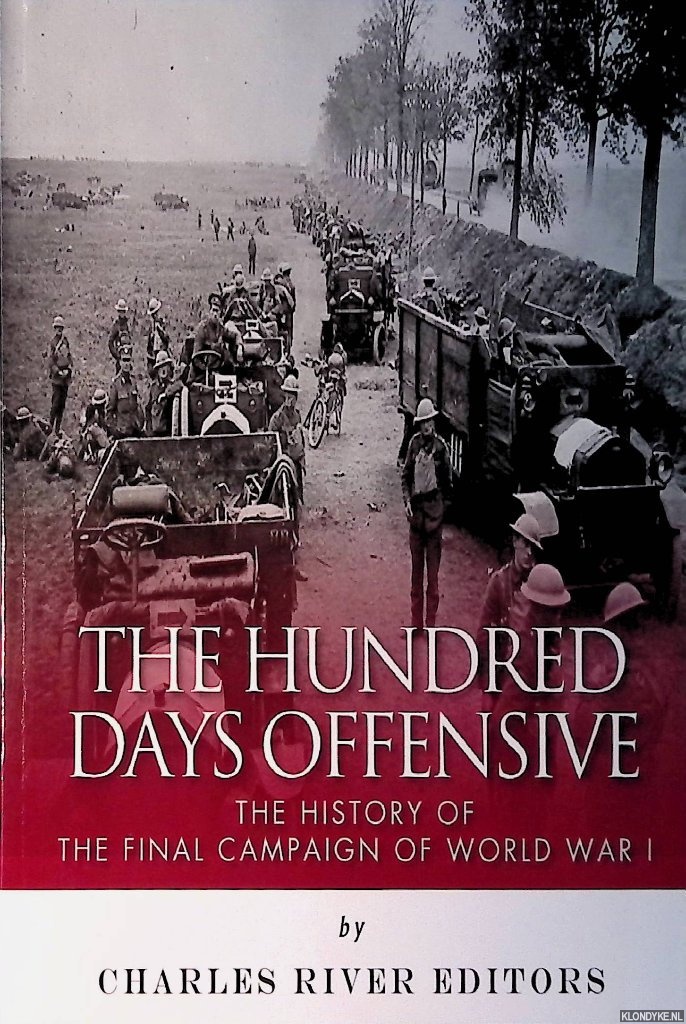
Onze boeken
The Hundred Days Offensive: The History of the Final Campaign of World War I
Door Charles River Editors
Categorie | WO I |
|---|---|
Boeknummer | #298437 |
Titel | The Hundred Days Offensive: The History of the Final Campaign of World War I |
Auteur | Charles River Editors |
Boektype | Paperback |
Uitgeverij | CreateSpace Independent Publishing Platform |
Jaar van uitgave | 2015 |
ISBN10 | 1511488301 |
ISBN13 | 9781511488303 |
Taal | Engels |
Beschrijving | Oriignal wrappers, illustrations in b/w, unpaged, 8vo. |
Samenvatting | *Includes pictures*Includes online resources and a bibliography for further reading*Includes a table of contents“No compromise on the main purpose; no peace till victory; no pact with unrepentant wrong -- that is the Declaration of July 4th, 1918.” – Winston Churchill, a month prior to the Hundred Days OffensiveWorld War I, also known in its time as the “Great War” or the “War to End all Wars”, was an unprecedented bloodbath in terms of its sheer scale. Fought by men who hailed from all corners of the globe, it saw millions of soldiers do battle in brutal assaults of attrition which dragged on for months with little to no respite. Tens of millions of artillery shells and untold hundreds of millions of rifle and machine gun bullets were fired in a... (Lees verder) conflict that demonstrated man's capacity to kill each other on a heretofore unprecedented scale, and as always, such a war brought about technological innovation at a rate that made the boom of the Industrial Revolution seem stagnant. As a result, World War I was the first truly industrial war, and it created a paradigm which reached its zenith with World War II and towards which virtually all equipment, innovation and training were dedicated throughout the Cold War and the remainder of the 20th century. To this day, modern warfare remains synonymous with tanks and mass infantry battles, although a confrontation of this nature has not occurred (except briefly during Operation Desert Storm) since World War II. For much of 1917, things went the Germans' way. With the Bolshevik Revolution underway, the Germans were able to move soldiers to the Western front as the Russians quit the war. Moreover, the Allied powers had failed badly in its Nivelle Offensive in May 1917 and suffered a defeat in November against at the Battle of Caporetto in Slovenia. Unbelievably, the French and British had not bothered to coordinate their commands until after those defeats: they finally formed a Supreme Council to coordinate their armies' movements and strategies. Despite those successes, when the United States joined the war in April 1917, it began mobilizing 4 million soldiers to join the war. The Central Powers knew that it would take months before the United States could land a substantial number of troops in Europe to join the fighting, and the Germans hoped to force the Allied powers to quit before the United States could make a difference. Thus, the Germans' Spring Offensive began in March 1918, using new infantry tactics to move on the most lightly defended points of the Allied trenches. The Germans quickly obtained a breakthrough and broke the Allied lines, pushing the Allied forces back nearly 40 miles, and the Germans were once again within less than 100 miles of Paris. Once again, however, the Allied powers halted the Germans' drive, with the help of reinforcing American and Australian troops. The Germans were right back where they started by July 1918, at which time about 10,000 Americans were arriving in France each day. The Allied powers began a counteroffensive known as the Hundred Days Offensive in August 1918 that was highly successful in pushing the Germans backward. In September, Bulgaria reached a separate armistice with the Allied powers, ceding control of the Balkans and cutting off German supplies. The defeated Ottoman Empire surrendered in late October. As the fortunes of the Central Powers waned, several lands in Austria-Hungary's empire began declaring independence. Finally, in November the German Kaiser Wilhelm II was forced into exile, and the Germans reached an armistice with the Allied powers at 11:00 a. m. on November 11, 1918. World War I had finally ended. The Hundred Days Offensive: The History of the Final Campaign of World War I analyzes the last and bloodiest campaign of the war. Along with pictures of important people, places, and events, you will learn about Hundred Days Offensive like never before, in no time at all. |
Pagina's | 54 |
Conditie | Als nieuw |
Prijs | € 6,00 |

Onze gebruikte boeken verkeren in goede tweedehands staat, tenzij hierboven anders beschreven. Kleine onvolkomenheden zijn niet altijd vermeld.










